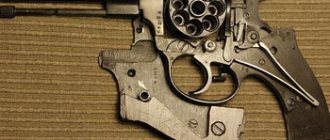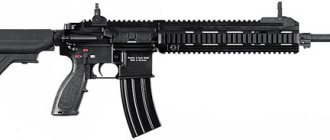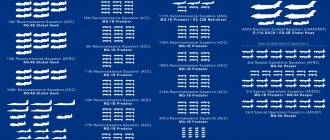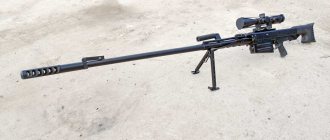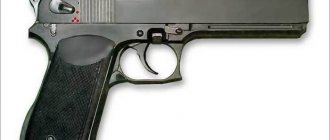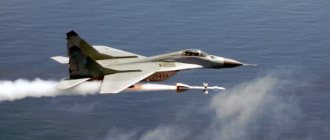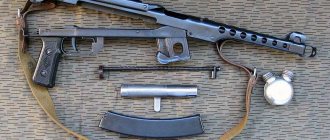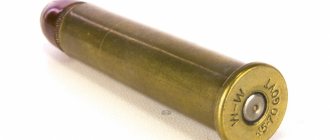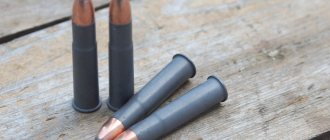Nowhere without a cartridge!
The basis of any small arms is the cartridge.
We dismiss sleeveless systems as too problematic. Let's focus on the polymer sleeve: its mass is small, while the plastic will reliably protect the propellant charge from external influences, dampness, rough handling, and will also help seal off the powder gases. Let the sleeve configuration be the simplest - a cylinder. It is convenient from many points of view.
The next question is the bullet. Here you need to remember that the enemy will most likely be wearing body armor; This means that you need a high penetration effect, while maintaining it at considerable ranges. Stupid scaling of conventional cartridges in the direction of increasing caliber and power will not suit us: not only the mass of weapons and ammunition will increase, but also recoil, and therefore we turn to the well-studied confrontation between “projectile and armor” in tank building, where sub-caliber arrow-shaped ammunition is widely used.
“Wait,” you say, “but this has already happened!” Yes it was. For example, in the Steyr ACR rifle, which was tested in the USA in the 1990s. But this rifle had a nominal caliber of 5.6 mm, and its arrow-shaped bullet weighed barely more than a gram and was the size of an average sewing needle. What kind of lethality and armor-piercing ability is there?
Steyr ACR rifle and its arrow-shaped bullets
The ideal weapon for the battlefield
People first started talking about a new sniper system from Kalashnikov four years ago. An unusual rifle was shown in 2017 at the Army 2017 forum. The Chukavina sniper rifle (microwave), as the sign said, created a real sensation. Compact, relatively light, energy-intensive.
According to representatives of the concern, this rifle was supposed to be a replacement for the outdated SVD - Dragunov sniper rifle. Expert circles have been saying that the Russian army vitally needs modern sniper systems for at least ten years.
“It is simply necessary to develop sniper systems. Military technologies do not stand still - new protective equipment for soldiers is being improved, and the distance of a sniper shot is increasing. Therefore, the requirements for sniper weapons are changing,” says military expert Alexey Leonkov .
Since 1963, in the Soviet and then in the Russian army, the main weapon of the sniper was a rifle designed by Evgeniy Dragunov. Simple, reliable - it quickly gained popularity both in our country and abroad. Its main advantage—self-loading—set it apart from all other sniper rifles. While the shooter fired one shot from a conventional sniper rifle, from the SVD the sniper managed to hit the target with two bullets during the same time. And if you add to this its unpretentiousness, you get an ideal weapon for the battlefield.
The SVD has been tested in numerous military conflicts on almost all continents. It was in service in thirty countries. It’s not for nothing that most experts called Dragunov’s brainchild the best sniper rifle in the world. But over time, even the most ideal weapons become obsolete.
This fate did not escape the legendary SVD, says small arms expert Semyon Fedoseev .
“The rifle is good, tested many times in battle. Its modernization is associated with technological elements - the ergonomics of the rifle and sights. In addition, it requires a modernized cartridge,” explains the expert.
TASS / Krasilnikov Stanislav
Reasonable dimensions
Let's take a look at Soviet developments of the 1960s–70s, where arrow-shaped bullets had a diameter of 3.5-4.5 millimeters, a length of about five centimeters and a mass of about five grams. This is no longer a needle, but a solid nail in the enemy’s coffin, flying out of the barrel at a speed of a thousand meters per second. Of course, you won’t achieve sniper accuracy (more precisely, accuracy) with such arrows, but the flat trajectory and shorter flight time dramatically increase the chances of hitting moving targets.
On the battlefield, as a rule, only dead bodies will be completely motionless.
As a result, our hypothetical cartridge will be about six centimeters long and one and a half centimeters in diameter with a nominal barrel caliber of ten millimeters. All this stuff will require about 2.5 grams of gunpowder, so the cartridge will ultimately weigh 15 grams - about the same as a 7.62x39 machine gun cartridge with much more interesting ballistics. Taking into account the dimensions of the cartridge, the 30-place magazine will be approximately comparable in height to the magazine from the AKM (modernized Kalashnikov assault rifle) - only without bending - and wider when viewed from the side. Of course, we will also make the magazine from impact-resistant polymer.
Let’s take a look at the design of the weapon’s mechanisms from the same Austrians from Steyr: a separate chamber movable in a vertical plane, lowered below the barrel to chamber the cartridge and extract the spent cartridge case. Just to save space, we will place the magazine not behind the chamber, but in front of it; and let the new cartridge be sent into it from the front, pushing the spent cartridge back. It will then fall out of the weapon through the window in the lower part of the body.
Automatic diagram of the Steyr ACR rifle
Of course, with such an arrangement of mechanisms, a general “bullpup” configuration suggests itself, which will allow you to have a fairly long barrel on the farm - and the weapon itself of reasonable dimensions. Solid high-strength polymers with metal reinforcement in critical areas are suitable for the body. Taking into account the selected ballistic characteristics of the cartridge, the recoil impulse of our machine gun will become comparable to the AKM, which means that firing bursts from it will become quite realistic. An additional bonus is that the barrel can be smooth, without rifling; that is, friction and heating in it will be much less, and the service life will be higher.
Possible delays and malfunctions that occur during shooting and ways to eliminate them
The delay that occurs during shooting should be eliminated by reloading, to do this, vigorously pull the bolt frame back by the handle, release it and continue shooting. If the delay is not resolved, then you need to find out the reason for its occurrence and eliminate the delay as indicated below.
Delay and their characteristics
Failure to feed cartridge. The bolt is in the forward position, but the shot did not occur - there is no cartridge in the chamber.
Stuck cartridge. The cartridge hit the breech end of the barrel with a bullet, the moving parts remained in the middle position.
Reasons for delay
1. Contamination or malfunction of the magazine.
2. Malfunction of the magazine latch.
3. Curvature of the bends of the side walls of the magazine.
Remedies
Reload the rifle and continue shooting. If the delay recurs, replace the magazine. If the magazine latch is faulty, send the rifle to a repair shop.
While holding the reloading handle, remove the stuck cartridge and continue shooting. If the delay recurs, replace the magazine.
| Delay and their characteristics | Reasons for delay | Remedies |
| Misfire. The bolt is in the forward position, the cartridge is in the chamber, the trigger is pulled - there is no shot. | I. Chuck malfunction. 2. Malfunction of the firing pin or firing mechanism; contamination or hardening of the lubricant. | Reload the rifle and continue shooting. When the delay is repeated, inspect and clean the firing pin and trigger mechanism; If they break or wear out, send the rifle to a workshop. |
| Failure to remove the cartridge case. The cartridge case is in the chamber, the next cartridge has buried a bullet in it, the moving parts have stopped in the middle position. | 1. Dirty cartridge or contaminated chamber. 2. Contamination or malfunction of the ejector or its spring. | Pull the reloading handle back and, holding it in the rear position, separate the magazine and remove the buried cartridge. Using a bolt or cleaning rod, remove the cartridge case from the chamber. Continue shooting. If the delay repeats, clean the chamber. Inspect and clean the ejector from dirt and continue shooting. If the ejector malfunctions, send the rifle to a repair shop. |
| Sticking or not reflecting the sleeve. The cartridge case was not thrown out of the receiver, but remained in it in front of the bolt or was sent back into the chamber by the bolt. | 1. Contamination of rubbing parts, gas paths or chamber. 2. The ejector is dirty or malfunctioning. | Pull the charging handle back, eject the cartridge case and continue shooting. If the delay repeats, clean the gas paths, rubbing parts and the chamber; Lubricate rubbing parts. If the ejector malfunctions, send the rifle to a repair shop. |
Need more upgrades!
Now we need a sight. Here, in principle, everything is clear: an electro-optical two-channel system (visible + infrared ranges) with digital signal processing and the ability to observe both through one of the selected channels, and with superimposition of a thermal image on the visible one. Of course, there will be a built-in laser rangefinder and atmospheric conditions sensors, as well as a ballistic computer that will automatically draw an aiming mark in the field of view, adjusted for the measured distance to the target.
In battle, it’s not enough just to shoot - you also need to hit at least sometimes.
It would also be nice to have a built-in multi-axis accelerometer. Firstly, it will allow you to introduce corrections to the angular velocity of the target when shooting at a moving target, and secondly, it will allow you to control the electronic self-timer when firing in bursts so that the next bullet flies out of the barrel in approximately the same direction as the previous one, and not where horrible.
What else? Encrypted wireless communication, transmission of video images to external devices (including a helmet-mounted display and commander's PDA) and other network-centric banality with automatically updated antivirus, voice assistant and client for social networks... well, okay, the latter may not be needed in the basic configuration, but only for extra money on paid premium accounts. Joke? Maybe a joke.
What does a sniper complex consist of?
“Accuracy” includes the following main elements:
- T-5000 rifle, modified to meet the requirements of the Ministry of Defense;
- Optical sight. It is allowed to use both the Russian “Daedalus” and its foreign analogues. Installation is carried out on the “Picatinny rail” located on the cover of the rifle receiver;
- Ammunition. The .308 Winchester and .338 Lapua Magnum cartridges can be used. Initially, T-5000 variants were offered for .300 Winchester Magnum, .260 Remington, .375 H&H and 6.5x47 Lapua.
It can be assumed that another reason for the abandonment of “Accuracy” was difficulties in providing ammunition. The fact is that the domestic 7.62x54R rifle cartridge is considered today unsuitable for sniper weapons. The creators of the T-5000 understood this very well, however, they did not even raise the question of developing new ammunition that would meet current criteria. Instead, the decision was made to use well-proven foreign cartridges.
The T-5000 rifle chambered for .338 LM is shown on the left in this photo, and the .308 Win is shown on the right
To be fair, the .308 Winchester and the Finnish .338 Lapua Magnum are today produced not only abroad, but also in Russia. Unfortunately, the quality of these licensed cartridges does not meet the standards required for use in sniper rifles. Even the T-5000 developers themselves strongly recommended that buyers use imported ammunition to avoid reducing the accuracy of fire. Meanwhile, one cannot count on regular supplies of military products from abroad under the conditions of sanctions against Russia. According to unofficial information, Russian snipers operating in Syria are already facing the problem of a shortage of ammunition.
To the future - only with a grenade launcher!
The obligatory under-barrel grenade launcher will complete our modest flight of fancy. Let’s take the domestic concept of the GP-25 with muzzle loading as a basis - it’s both faster and has fewer restrictions on shot length. Of course, the grenade launcher must have an interface with the sighting system. It will automatically recognize the type of loaded shot to make adjustments to the sight and, if necessary, allow a programmable detonation of a grenade at a distance or in case of a direct hit on the target.
We will also make grenades not simple, but active-reactive: first, a small charge knocks the grenade out of the barrel, then its accelerating solid propellant rocket engine (solid propellant jet engine) is turned on, and “let’s go!” This will either increase the effective firing range of a grenade launcher, or use heavier (and therefore powerful) warheads, including over-caliber ones.
As you can see, nothing fantastic, everything is quite feasible. But, as you know, “it was smooth on paper”, but what will happen in reality... What do you think - what kind of underwater rake might the developers of such a blaster encounter in the near future?
